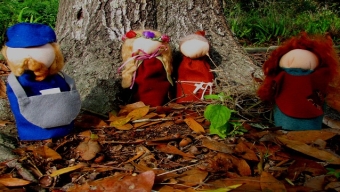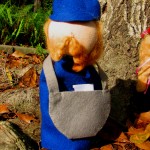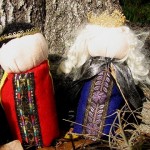“We must do everything in our power to help the children to develop fantasy.” ~ Rudolf Steiner.
Puppetry (finger puppets, small puppets and marionettes) are common within Waldorf schools because they are a living play imbued with inner imagination and fantasy. Puppet shows draw the child into a story, watching it unfold step by step, grow and change, and these pictures are taken right into the stream of life forces, without creating hard and fixed impressions. The draw forth from children their imagination and allow the story to take them where they need to do as far as the inner life working pictures.
Puppets and puppet shows are not only beautiful, but provide many advantages. Rahima Baldwin Dancy, a Waldorf early childhood educator, notes that “when stories and fairy tales are translated into cartoons or movies, they lose their evocative quality and are often too powerful…for young children. But when stories are acted out in front of the children using stand-up puppets or marionettes, the experiences have a very calming and healing effect on the children.”
Because of its value, puppetry has fast become one of the most popular forms of educational instruction in traditional elementary schools. The California State Curriculum Guide states that puppetry is an ideal instrument for aiding in language development. According to Frisch (2004), at their most basic, puppets are an exceptional means of conveying a message. However, the value goes much, much further. Puppetry integrates more art forms, disciplines and subject matter than any other creative or dramatic medium. Exploring the puppet theater arts opens the door to history, music, math, science, creative writing and language arts, painting, sculpting, acting, dance and many other disciplines that have their roots in a multitude of cultures, some of which have puppetry traditions that extend back for thousands of years.
Through puppetry children can learn new ways to express themselves while learning new skills, leading the child on a path of self-discovery and expression that help instill confidence and boost self-esteem. The cooperative effort needed to create a puppet show develops a child’s ability to work with others, share ideas and solve problems.
Storytelling is felt by some to be one of the arts that are diminishing in importance in our culture. Yet our curriculum places strong emphasis on this experience for children. Each day in the Seaside Playgarden, children sit in the circle to watch and listen as their teacher tells from memory a simple folk tale or a fairy tale. Visual images are created within the active minds of each child. The stories change with the cycles of the year and much has been written about which stories are important and why. On special occasions a more complex story may be told with the support of simple felt table top puppets or silk marionettes the teacher and parents have made.
Storytelling imbues the imagination and fantasy, and is a loving way of communicating values, principles, and challenges, among others. Oral stories may be curative (Dancy, 1989, pg 184) where a made-up story may be told to a child or group of children who are exhibiting a particular problem or behavior that you hope will change. In our school, curative stories in kindergarten are about unruly horses or chatty squirrels.
While stories can reflect life’s challenges, the oral storytelling provides a strong basis for the development of “picture consciousness” (Meyer 1981), or our imaginations. Dancy (1989, pg 168) notes the “role of imagination or the ability to think in images is recognized as an important component in creative thinking. Albert Einstein said he discovered the theory of relativity by picturing himself riding on a ray of light.” Meyerkort, who heads the Waldorf early-childhood teacher training program in Great Britain, notes that imagination is essential for many reasons: initiative (to see potential, rather than static existence), compassion (imagine and empathize with another’s predicament), love (imagine a person’s potential, possibilities for growth).
Images that are envisioned from something a child hears in a story are based on their imagination, are not static, and can transform over time in one’s “mind’s eye”. On the contrary, images from television or movies, or even books with detailed pictures, take the imagination away from the child and provide it to them in a static way that “sticks”. Thus oral storytelling embraces the inner fantasy and creativity in all of us.
Our personal favorite is to make our own table puppets which require no strings (like marionettes), hands or fingers. They are basically a waldorf doll style head and then a tubular body (imagine a waldorf doll head on a toilet paper roll). The body is made from a nice heavy felt and then filled loosely with batting to help give it weight and keep shape. Over the years we must have made over 100 of these and many of them still reside with us, while some have been lovingly passes along to families with younger children.
With wit and ingenuity, Maija Baric shows you to transform wooden spoons, pieces of string, holey socks, outgrown clothes and other scrap materials into beautiful, durable and functional theatrical puppets. Once you have made your puppets, discover how to bring them to life, build staging, scenery and props, create sound effects and devise performances. Your puppet creations will bring something truly magical to the everyday world: use them to transform storytime at home or in the classroom; ease children’s bedtime rituals; and make a birthday or other occasion really special.
Other Recommended Resources Include
<A HREF=”http://ws.amazon.com/widgets/q?rt=tf_cw&ServiceVersion=20070822&MarketPlace=US&ID=V20070822%2FUS%2Fwaldorfhomesc-20%2F8010%2Fb2a8df33-8bd8-407f-9004-c09f328febda&Operation=NoScript”>Amazon.com Widgets</A>Get more inspiring articles by Like’ing our Facebook Page Here >>






















